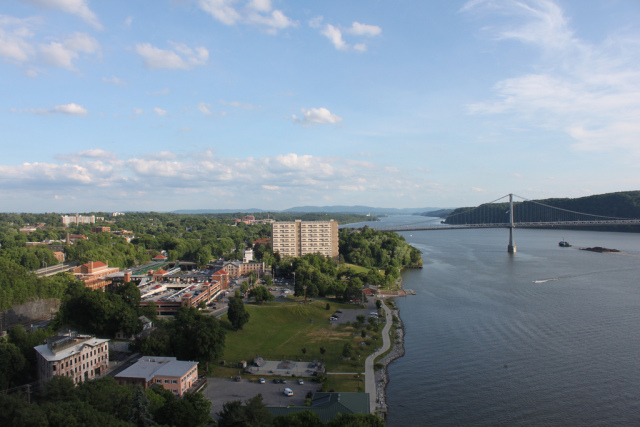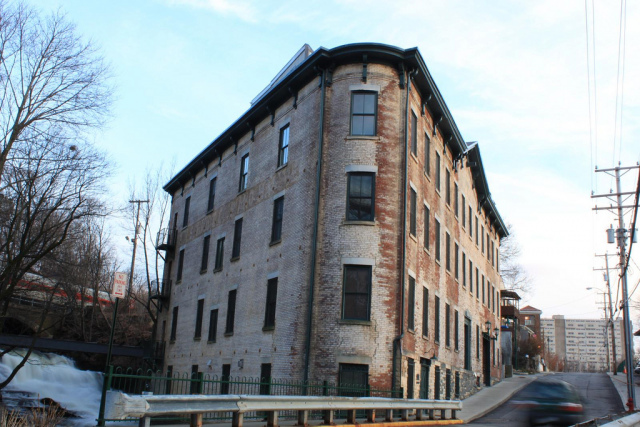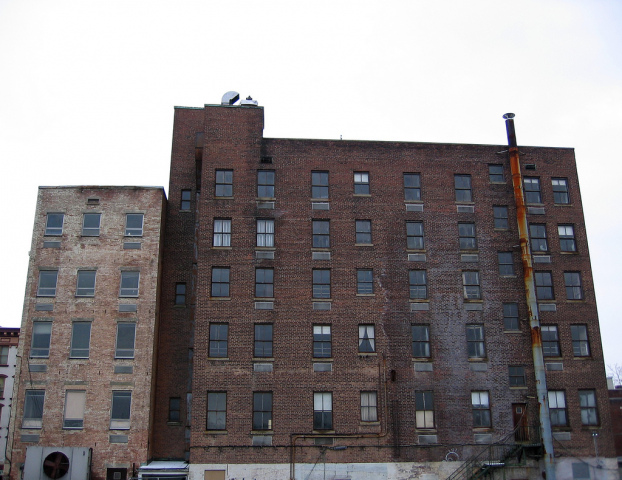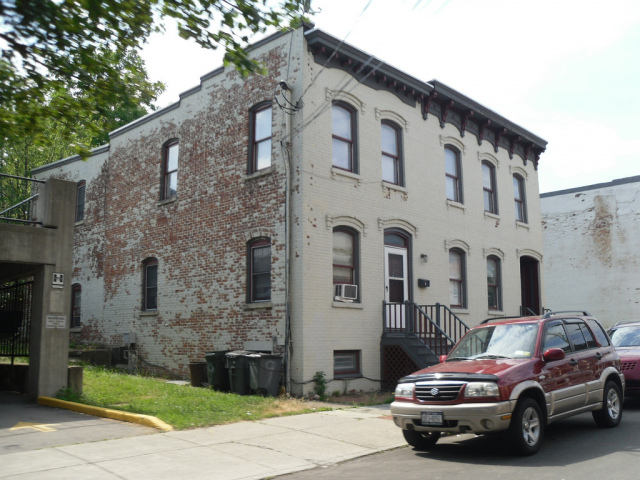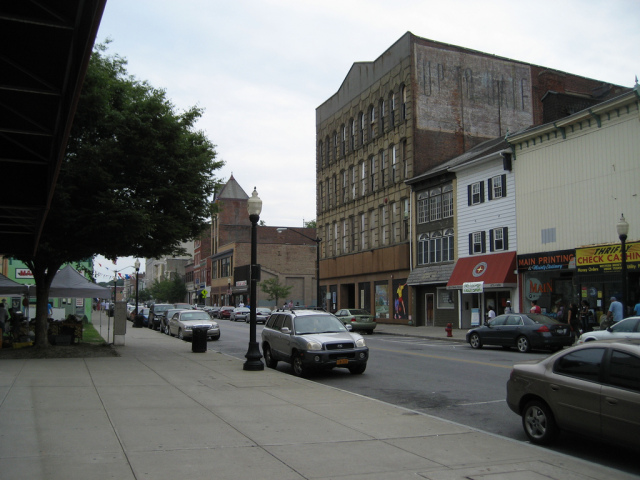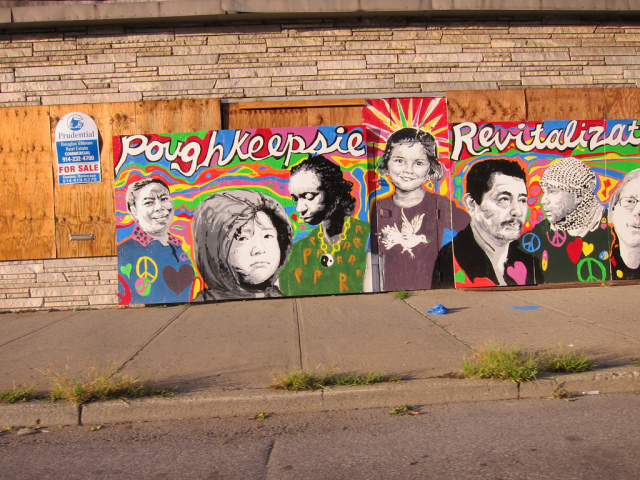A Poughkeepsie School of Urban Studies
|
In my Urban Studies classes, I occasionally urge students to articulate and embrace a “Poughkeepsie school of urban studies. ” It makes for good laughs when I tell them that, but I want students to appreciate how so many key forces shaping cities today can be found in the city outside the gates. Just as importantly, I want them to think about what I call “the city in our heads.” Critical urban studies pedagogy requires we be intellectually and morally responsible for the biases and blindspots of our paradigms, theories, and histories. That’s what’s at stake, for example, in urban studies debates over the institutional dominance of the Chicago School of Urban Studies or New Urbanism. But this notion of the city in our heads also implies we can exercise pedagogical agency to direct scrutiny and mobilize response to urban conditions, problems and prospects of our critical, deliberative choosing. Photo by Joseph A © 2010 Studying our neighboring city of Poughkeepsie provides an excellent vantage point for inquiry into going to the source and engaging the outside world—two pedagogical values frequently endorsed within the college. It also affords us the opportunity to scrutinize institutional aspects of the college’s relationship to “community,” in terms of the local places that faculty, administrators and staff live and economically sustain, but also the social body we hope to constitute with our students here on campus. To that end, here I review the Poughkeepsie dynamics and contexts that I’ve found to be the most intellectually interesting and morally compelling as an urban studies instructor at Vassar College for the last 12 years. My hope is to start a discussion by way of prompt and provocation, not close it around the topics or analyses I present below. THE URBAN CRISIS Incorporated in 1854, Poughkeepsie’s growth over three centuries illustrates a traditional scholarly wisdom about how urban geographies develop. The city rose to regional prominence as a small distribution and industrial satellite to the New York City metropolis, and as commercial center and county seat to a mostly rural Dutchess County. (Note that “city” isn’t just an analytical category but also an administrative designation by the state; many counties in New York don’t have cities.) The 1889 erection of the railroad bridge, the steady industrialization of the riverfront (led by Matthew Vassar and others) up through the WWII era, and the city’s 1983 connection to the Metro North commuter rail illustrate the causal importance of natural geography and transportation infrastructure in drawing people and goods. This historic pattern became scientific axiom in the “urban ecology” paradigm that University of Chicago sociologists first articulated in the early 20th century. Poughkeepsie’s growth came to a halt after WWII, when businesses and middle-class residents fled to surrounding suburbs (including the Town of Poughkeepsie, the location of Vassar College) and other states, leaving behind a disproportionately low-income and non-white populace. Consequently the city’s tax base deteriorated, reducing funds for social and police services at a time when residents needed them more. The 1970 establishment of the Spackenkill school district out of the city’s affluent Southside left the Poughkeepsie school district with a poorer student body and declining trends for graduation and college acceptance. Today, 9.6 percent of the city’s population is unemployed, and 22.5 percent don’t have a high school diploma, two trends well outpacing the state and national figures. Poughkeepsie’s experience was characteristic of the post-WWII urban crisis that swept through many cities of the U.S., particularly in the Northeast and Midwest. For social scientists and planners trained in the reigning urban ecology paradigm, the cycle of decline reflected rational household and business responses to transportation advances, aging urban infrastructure, and suburban opportunities. Importantly, by the 1960s these academic constituencies started collaborating around the multidisciplinary banner of “urban studies” to analyze and propose interventions in the battlegrounds of the urban crisis. Our intellectual enterprise, it seems, doesn’t stand apart from the history it records. The city also provides ample evidence for the “urban political economy” paradigm’s rebuttal to urban ecology: the shape and fate of cities are driven by elite agency, starting with local industrialists. Labor control was a motive for many businesses that fled Poughkeepsie for lower-wage, non-union states in the West and South. IBM’s complaints about Main Street traffic prodded the city to build the Route 9 and 44/55 express arterials, while the concerns of its white-collar workforce were instrumental in establishing the Spackenkill school district. Although IBM and other firms rarely involve themselves in electoral politics, Poughkeepsie leaders promote a “business first” agenda and regularly tap local executives for civic and business associations. These groups’ dependence upon the dictates of big employers puts into context the local umbrage to Vassar’s recent withdrawal from the United Way. Poughkeepsie’s elected officials and administrative agencies exercised their own undemocratic governance in their embrace of Urban Renewal policies of large-scale housing and infrastructural developments. From the late 1950s to the mid 1970s, city government tapped federal, state, and private funds to build the modernist landscape of 3-lane arterials, vast parking lots around the Main Street corridor, low-income housing projects, the high-rise Rip Van Winkle apartment tower on the city’s waterfront, the downtown convention center complex, and a four-block pedestrian mall closed off to auto traffic along downtown Main Street. Yet despite (arguably because of) these so-called improvements, Poughkeepsie lost further housing units, businesses and residents during the Urban Renewal period. POUGHKEEPSIE’S TURNAROUND Enthusiastic speculation greeted the 2000 Census finding of the city’s first population growth in fifty years; the growth has slowed down but remained positive a decade later. Yet many residents still face serious hurdles in terms of unemployment, school quality, poverty and crime, raising the question: Is Poughkeepsie experiencing the “urban renaissance” enjoyed by cities like New York, Washington, D.C., Seattle, Portland and San Francisco? Or is it still mired in the legacy of the urban crisis? In fact both scenarios may be true—a situation that calls attention to the regional scale and the tides of metropolitan restructuring washing ashore in Poughkeepsie. Concurrent with New York City’s post-industrial transformation into a financial/creative capital, Manhattan’s accelerating economy has pushed population, employment, and rising property values outward to Brooklyn, Queens, northern New Jersey, Westchester County and southern Connecticutt. Poughkeepsie so far is not one of these new metropolitan hotspots, although the high occupancy rates of apartments and condos around Poughkeepsie’s train station suggests some of the recent population growth can be attributed to commuters moving further north for more affordable costs of living. Photo by Tarik Elseewi © 2011 A second source of population growth, possibly a larger one—we still lack a definitive picture here—is transnational immigrants. Poughkeepsie has a long history of ethnic diversity, from Germans, Irish, and Italian immigrants arriving around the turn of the 20th century, to the mid-century stream of West Indians who introduced cultural and linguistic diversity to Poughkeepsie’s black population. Since the late 1990s, the largest flow has come from Latin America. Many countries are represented, but it appears three states in Mexico (Oaxaca, Puebla, and Veracruz) account for most of the current households who primarily speak Spanish at home. The Latin American force of urban revitalization is undeniable in Poughkeepsie; today many Spanish-speaking restaurants, stores, and other businesses occupy Main Street storefronts that were vacant only a few years earlier. Increasingly, Poughkeepsie experiences an urban pressure coming from an unexpected direction, out of the county’s exurbs. Over the last decade, sleepy towns like LaGrange, Pleasant Valley and Hopewell Junction have seen a visible spike in the construction of “McMansions” and other new housing. Almost certainly metropolitan commuters seeking affordable housing close to interstates and parkways have led this exurban growth. It’s premature to anticipate that exurban in-fill development will substantially increase Poughkeepsie’s population numbers or property values, although signs of indirect impact are evident—most notably, the steadily increasing ridership on the Metro North commuter rail that terminates at Poughkeepsie’s train station. At this stage, what’s more significant is the direction of population flow, which has been prefigured by the cultural revalorization of the broader region’s place meanings and physical amenities. THE MID-HUDSON VALLEY’S SYMBOLIC ECONOMY For some time now, the Mid-Hudson Valley surrounding Poughkeepsie has been repeatedly “discovered” as a destination for tourism, shopping, eating, gallery-hopping, buying vacation-homes, and enhancing personal quality of life. Neighboring riverfront cities Beacon and Hudson have been radically transformed by the establishment of the Dia: Beacon museum and a thriving antique-store district, respectively. Out-of-towners have especially changed the texture of small towns where independently-owned restaurants and stores have flourished: Woodstock, Saugerties, Rhinebeck, Rosendale, and other places cited in media coverage and internet chatter about “the new Brooklyn.” Since the 1970s, Poughkeepsie’s contribution to the valley’s tourism sector has centered upon its riverfront. In 2009, this amenity was considerably upgraded by the Walkway over the Hudson, which turned the abandoned Poughkeepsie-Highland Railroad Bridge into a pleasing pedestrian walkway for taking in views of the river and landscape (as well as strangers enjoying public space—an uncommon sight in Poughkeepsie). How might we understand the new role for the region’s amenity infrastructure? Ultimately, its essence is symbolic, forged over centuries of metropolitan gazes cast out of NYC and elsewhere. From 17th-century Grand Tours to 20th-century chataquas, the valley has long exported place-images and place-myths that depict idyllic opposites to metropolitan beholders’ anxieties: the concrete jungle, the urban rat-race, the pretense and deceits of metropolitan society, a declining connection to nature and agriculture, and so on. Today, the key context is the growth in NYC and other cities of professional, cultural, and media sectors. Their middle-to-upper class employees, heavily overworked and less securely employed, characteristically have considerable flexibility in the time and location for work, and a voracious appetite for aesthetic and lifestyle inspirations. From this crucible of work/life conditions comes the growing demand for experiencing new places, which the Mid-Hudson Valley customarily serves up via village Main Streets and rustic retreats. Additionally, growth in professional, cultural, and media sectors has revived many neighborhoods and cities once thought lost to the urban crisis, but which now appear well suited for small-scale creative activities, bohemian nightlife and spacious apartments carved out of old factories and storefronts. Brooklyn is the emblem here, but even some still-struggling cities such as Baltimore have new wind in their sails thanks to their swelling hipster enclaves. It remains to be explained why the cities of the Mid-Hudson Valley have fared unevenly, considering they all have ample stock of exposed-brick real estate. Beacon and Hudson now have thick traffic in visitors and shoppers, although a substantial benefit in jobs and public services has yet to materialize for their working-class residents. The city of Kingston appears to be in early stages of a modest arts-based revitalization, while the city of Newburgh remains mired in troubling levels of disinvestment and crime. Poughkeepsie seems to be positioned somewhere in the middle, certainly doing better than before, but curiously stalled considering its enviable assets: the Walkway, entrepreneurial immigrant communities, and of course its neighboring institutions of higher education. Photo by brit_robin © 2010 Photo by dougtone © 2010 POTENTIALS FOR A BROADER REVITALIZATION In this regard Poughkeepsie offers a useful case for testing competing macro/structure versus local/agency theories of urban revitalization. Local/agency theories give us cause to examine various initiatives and local forces that could expand Poughkeepsie’s modest turnaround into broader gains for the city’s population. To begin, Poughkeepsie has a deep and sometimes overlooked history of activism and protest. The Civil Rights/Black Power period in the 1960s coincided with Poughkeepsie’s Urban Renewal policies, when many African-American residents were displaced from what one city plan called downtown’s “Negro ghetto.” As in other American cities, civil rights activism in Poughkeepsie became institutionalized in human services and neighborhood organizations (such as downtown’s Family Partnership Center), and several parks and institutions bear the names of African-American icons and leaders. Affordable housing is another arena that Poughkeepsie groups (particularly the nonprofit Hudson River Housing) have tackled commendably, restoring single houses and apartment complexes to add back housing units lost to the urban crisis. Environmentalist sentiment has a long record in the region, going back to the mid-19th-century Hudson River School of landscape painting, but the local history of advocacy generally begins in 1966 with the Hudson River Sloop Clearwater, which was based in Poughkeepsie until 2009, when it relocated to Beacon. In the wake of the Clearwater (no pun intended), a number of organizations and initiatives proliferated regionally to clean up the river and protect open space. Today, green sentiments echo throughout Poughkeepsie in community gardens that occasionally spring up here and there. The nonprofit Poughkeepsie Farm Project manages the city’s farmers market and operates a community supported agriculture, taking care to subsidize fresh produce for low-income residents. Most recently, a coalition of agencies and institutions have rolled out a community food assessment, documenting food insecurity and catalyzing community discussion about improvements in Poughkeepsie’s food system. (Disclosure: I oversee the community food assessment’s household survey component.) Theories and practices of urban design can be explored in downtown’s Main Street. Since shedding its moribund state as a neglected pedestrian mall, Main Street along the central business district has higher vacancy rates, occupied storefronts, a few higher-end restaurants, and a handful of civic spaces open to public uses alongside several government and nonprofit establishments. A few blocks up, the “Middle Main” district (also the name of a neighborhood revitalization association) features a new Associated Supermarket, the city’s first large grocery store in twenty years. The historic Luckey Platt department store now contains six stories of residential apartments, while a former vacant lot that for years dominated a large stretch of Main Street (next to the former Congress Tavern) now contains a new mixed-use storefront/residential complex. Photo by brianwbailey222 © 2010 These new Main Street developments illustrate several design principles associated with the so-called New Urbanism. They cluster near residential streets to the north and south; mix residential, commercial, nightlife, government and nonprofit uses; inhabit an older stock of buildings and commercial alleys that could incubate the low-margin businesses typical of small-scale urban enterpreneurs; are served by public buses and the nearby train station; and give new shine to a mid-20th century urban architecture that survived Urban Renewal. So why hasn’t the signage that points visitors to and from the nearby Walkway diverted a substantial stream of out-of-towners? Some planners might argue there isn’t enough New Urbanism. Downtown Main Street can feel like an oasis in a desert of Urban Renewal blight, cut off from residential blocks by sprawling parking lots and three-lane arterials. Architectural critics might argue that the city’s built environment has no planning integrity, having been too long subject to a modernist ethos of demolish-and-rebuild to suit the latest design fad. Political scientists might emphasize the inefficacy of the city’s elected officials, whose adherence to traditional practices of economic development (seeking federal money, luring big employers, giving low priority to social services) has blinded them to the possibilities for immigrant- and amenity-based models of urban revitalization. Photo by EMFPhoto © 2011 Other analysts might point to macro/structural factors to explain Poughkeepsie’s apparently stalled redevelopment. Clearly, the current economic downturn has slowed any momentum toward further revitalization. But beyond this, few economists would be surprised by the city’s failure to attract big employers in knowledge-based sectors given its poor schools and low rates of educational attainment, no matter how many tax-relieving federal enterprise zones the city receives. Cultural and media analysts might point to the durability of stigmas lingering over Poughkeepsie and other cities wracked by the post-WWII urban crisis. Two years before the U.S. Census marked the city’s population turnaround, a 1998 New York Times headline read, “Poughkeepsie, in a Long Tailspin, Now Copes With a Clouded Image.” Since then, little of the recent good news seems to have pierced the dismal common wisdom about Poughkeepsie, at least for the native-born, educated populace most likely to seek new lives in scruffy urban settings. Perhaps foreign immigrants should receive the credit for the city’s revitalization, since the suburbs and exurbs have drawn the educated, middle- and upper-class migrants looking for someplace that’s generally not Poughkeepsie. CONCLUSION Whatever perspective or hypothesis one adopts to understand the current moment, change is definitely afoot in Poughkeepsie. I don’t think it’s coincidental that over the last decade the college has seen the number of Urban Studies majors double and a noticeable handful of its graduates stay on to live and work in Poughkeepsie. It’s an opportune moment then to study and participate in the city, but also to take seriously its lessons regarding our institutional implications in its problems and promise. What kind of shadows does Vassar College cast over Poughkeepsie in terms of economic support, college life policies, civic leadership, engagement with local institutions, and employees’ residential patterns? Are there instructive parallels within the college to the city’s legacies of elite governance, organizational response, and grassroots protest? Although every stripe of pedagogy needn’t take up “the city in our heads” so directly, I think it’s intellectually worthwhile and, yes, morally compelling that we as institutional and local citizens address the Poughkeepsie agenda for urban revival and social justice. |
